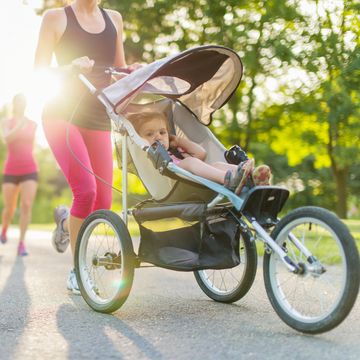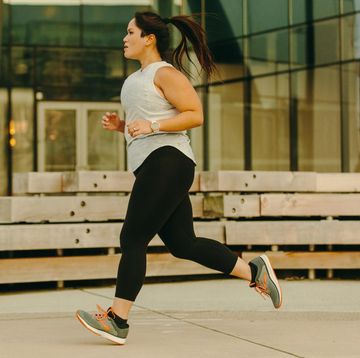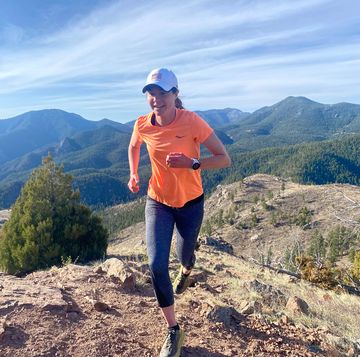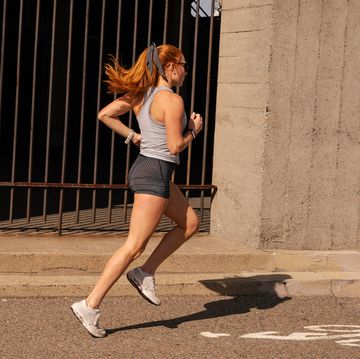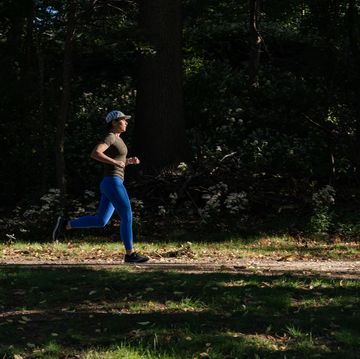Whoever said that you can't get too much of a good thing must not have been a runner—especially not a female runner.
Sure, running helps you beat stress, lose weight, look fantastic, meet great friends, gain more confidence, stay mentally sharp, live longer, and generally feel like a goddess. But go too far and running can make you moody, and even make you hurt.
To help make sure you never cross that line, use this guide. It tells you everything you need to know to run healthfully and sensibly for a lifetime.
Your Hips
Due to our wider hips, we women can develop more than our share of below-the-belt aches, including bursitis, an inflammation in the bursa sacs that surround and cushion your hip joint. “Think of bursitis as a kind of blister,” says Nicholas DiNubile, M.D., an orthopedic physician in Havertown, Pennsylvania, and consultant to the Philadelphia Ballet. “If the joint isn't aligned, you'll have rubbing. And if you run enough miles, that rubbing will create real irritation.”
To prevent bursitis, wear the right shoes for your foot type, avoid running on sloped surfaces, and be sure to increase your mileage gradually (no more than 10 percent per week). If you're experiencing hip pain now, do stretching and strengthening exercises that target your hips and thighs, and cut down on your mileage, says DiNubile. If you ignore hip pain, you could end up with other problems, such as knee injuries or even stress fractures.
Your Knees
Just one joint down from the hip is the knee—the second victim of our wider-hips problem. Many women suffer knee pain from patellofemoral syndrome, in which the underside of the kneecap rubs against the bottom of the thighbone, causing irritation, inflammation, and pain, says Richard T. Braver, D.P.M., a sports podiatrist in Englewood, New Jersey. This syndrome is especially common in women because our hip-to-ankle line often isn't perfectly straight, creating either knock-knees (when the legs curve in at the knee), or bowlegs (when the legs curve out).
To prevent and relieve knee pain, do exercises to strengthen your quadriceps, and make sure you're running in the correct shoes, Braver says. In particular, look for shoes with good medial support, which will keep your feet and ankles from rolling in too much. You also should cut back on your mileage, at least until the pain goes away.
Your Shins
Pain along the front or inside edge of the shinbone, known generically as shinsplints, is another problem for women. We tend to have looser ligaments in our knees and ankles, which means we're more likely to overpronate. That places extra strain on all the muscles in our lower legs, including those in the shin area.
If your shins are sore, shift to nonimpact workouts until the pain disappears, and add stretching and strengthening exercises to your routine. You also should check your shoes for adequate arch support and appropriate stiffness, says Braver. “Lots of women come to see me with shin pain, and it turns out they're running in shoes that are way too stiff.”
A runner who overpronates might buy a rigid shoe hoping to keep her ankles from turning, he explains, but many motion-control shoes are simply too stiff for a woman's less-muscular foot to bend. “If you hear a slapping noise every time your foot hits the ground, your shoes are too stiff,” he notes.
Trying to run through pain is a big mistake, especially if the pain is worst at the beginning of your run. By continuing to overload your muscles, you could cause a stress fracture, a tiny crack in the bone due to repeated strain. In the case of shinsplints, the crack forms after your already-tight muscle is gradually pulled away from the bone, taking its connective tissue with it. If you have a stress fracture, you'll have to give up running (and any other impact activities, including power walking) for several weeks or longer.
Your Feet
If you're experiencing pain anywhere in your legs or hips, the cause of the problem may be your feet—or, more specifically, your shoes. Women typically have narrower heels than men, and many women buy shoes that are too small to keep their heels from slipping, says Braver. Because we tend to pronate more, we also need shoes with the right mix of stability and support.
Shoes that don't meet those requirements can cause pain in any of the joints of your body, including those in your feet. The wrong shoes can contribute to a condition called plantar fasciitis, an inflammation of the fibrous tissue that runs along the bottom of your feet. It often produces a stabbing sensation in the bottom of the heel or arch.
The best shoes for your feet will feel snug enough to prevent sliding, but loose enough to allow your feet to flex properly.
Most specialty running stores can give you advice about the best shoes for you. To figure out your foot type, do the wet test: Step out of the shower onto a piece of paper, and trace the outline of your footprint. Then take it to the store with you, along with an old pair of running shoes. These items will help the salesperson determine the shape of your arch and the way your foot typically moves when you run. If the best off-the-shelf shoes don't cure your problems, try some drugstore inserts, or see a podiatrist for custom-made orthotics.
Your Breasts
You have to love your sports bra, because it gives you the support you need during running. But you probably curse it, too, if it digs into your skin after a few miles, or worse, leaves you chafed with little wounds that torment you once you hit the shower.
Newer fabrics are less likely to rub, but many women still suffer “bra burn” from every model they try. A properly fitting bra should be snug but not suffocating, with no loose spots that might bunch up. The bra should reduce bouncing to almost none. (To test a bra, jump up and down in the dressing room). If you're still getting rubbed, apply a bit of petroleum jelly or other lubricant to trouble spots before your runs. If you're doing long runs, bring along a trial-sized tube in your waist pack for touch-ups along the way.
Your Lungs
Asthma and its cousin, exercise-induced asthma (EIA), are more common in women than men—and more common among athletes than the general public. Asthma involves two factors: chronic inflammation of the airways, and a hyper-responsiveness to various triggers.
Some common triggers for asthma and EIA include: cold air, hormones (many women are more prone to attacks right before or during their periods); and physical and emotional stress. “Stress definitely affects the smooth muscle in your airways,” says Cathy Fieseler, M.D., an ultramarathoner and sports-medicine practitioner at the Cleveland Clinic Foundation. In fact, stress can create a condition called vocal-chord disorder, which produces asthma-like episodes but is actually a physiological response to anxiety.
Dehydration can also contribute to an attack, so drink eight ounces of fluid every 15 to 20 minutes while exercising. And clear your diet of possible asthma triggers, such as wheat gluten (found in any food containing white or whole wheat flour), dairy products, soybeans, and nuts. If your symptoms persist, see your doctor.
Your GI Tract
Though any runner can suffer from heartburn, diarrhea, and stomachaches, women are particularly prone. That's because more often than men, women tend to develop irritable bowel syndrome—a condition that can include alternating episodes of diarrhea, constipation, and abdominal pain—as well as lactose intolerance, the inability to digest dairy products.
If you experience chronic GI problems, monitor the foods you eat to see if you can determine a pattern. Common culprits include dairy products, caffeinated beverages, chocolate, fried foods, and acidic fruits and vegetables such as tomatoes and oranges.
Also, for most runners, a big meal before a big workout won't sit well. “What you can eat, and how long you have to wait after eating it, vary enormously from person to person,” says Fieseler. “I've seen people in ultras who can wolf down a cheeseburger while they're running, but most people need at least an hour between eating and exercise.” In some female runners, the hormonal swings associated with the menstrual cycle and pregnancy can exacerbate indigestion, meaning you'll need to be even more careful of what and when you eat.
“Generally speaking, the greater the intensity of your workout, the less blood will reach your digestive tract, and the more digestive troubles you might have,” Dr. Fieseler explains. “And exertion definitely loosens your esophagus, the gatekeeper for everything you've just eaten, which makes you more vulnerable to heartburn.” Unless your workout is no more grueling than a stroll around the block, you're better off allowing your body to process a meal before you ask it to go aerobic. If you're starving, grab an easy-to-digest energy bar or a carbohydrate drink.
Your Reproductive Organs
Missing a period (or two) is fairly common among women, especially those at the beginning of their reproductive years. But stress, and particularly the stress that comes from overtraining and/or undereating, can trigger a potentially dangerous suspension of menstruation called amenorrhea. Women who go for three to four months without menstruating risk a range of health problems, all related to the lack of circulating estrogen in their bodies. For example, amenorrhea leads to osteoporosis in older women, but it also weakens bones in young women, leaving them susceptible to stress fractures.
Simply exercising regularly doesn't put you at risk, says Fieseler. But eating too little and running too much definitely will. If your periods are erratic, take a good look at your training plan, and make sure you're eating and resting enough. If you've gone more than three or four months without a period, talk with your doctor.
Your Bladder
Urinary-stress incontinence—the condition in which an adult leaks urine while sneezing, laughing, or running—strikes more than 10 million adult women in the United States. In fact, about half of all women will experience it at some point in their lives. It's most common in women who have had children and/or have passed menopause, but many young, childless women have it, too.
To prevent incontinence, Fieseler recommends eliminating diuretics (especially coffee) from your diet. If you've had children, ask your doctor about a pessary, a small, doughnut-shaped device that will give your bladder extra support. (You also can insert a tampon before you run, suggests Fieseler.)
And try Kegel exercises, in which you contract the muscles you use to stop the flow of urine. “Try to hold each contraction for 10 seconds or so. You can practice at every traffic light,” Fieseler suggests. If all else fails, chart a few pit stops into your running routes. “Don't cut back on fluids before your run to avoid urinating,” she warns. “Dehydration is a much bigger problem than a little leaked urine.” Dehydration can actually lead to a bladder infection, which will increase your urgency even more.
Listening Device
Experts tell us that the best way to keep ourselves in optimal health is to pay attention to our own bodies. “Your body will tell you exactly what to do if you listen to it,” says Cathy Fieseler, M.D. To become better acquainted with your body, track the following six factors in your training log:
1. Your menstrual cycle (assign each date in your log a number corresponding to the day in your cycle, starting with 1 on the first day of your period)
2. Your mood (before and after your run)
3. Your weight
4. Your daily diet (including when and how much you eat)
5. The time of day and weather conditions of your run
6. Any discomforts you feel while running (digestive distress, headache, wheezing, etc.)

Elizabeth Comeau is a marathoner, journalist, triathlete, coffee addict, mother, writer. Comeau worked as a journalist at The Boston Globe for 14 years, first as a reporter, then in marketing and events. To Elizabeth, being a runner means more than just racing fast, or running hard: It’s about pushing herself to do things she didn't know she could do. Her philosophy is that if it seems impossible, she simply has to try it.


